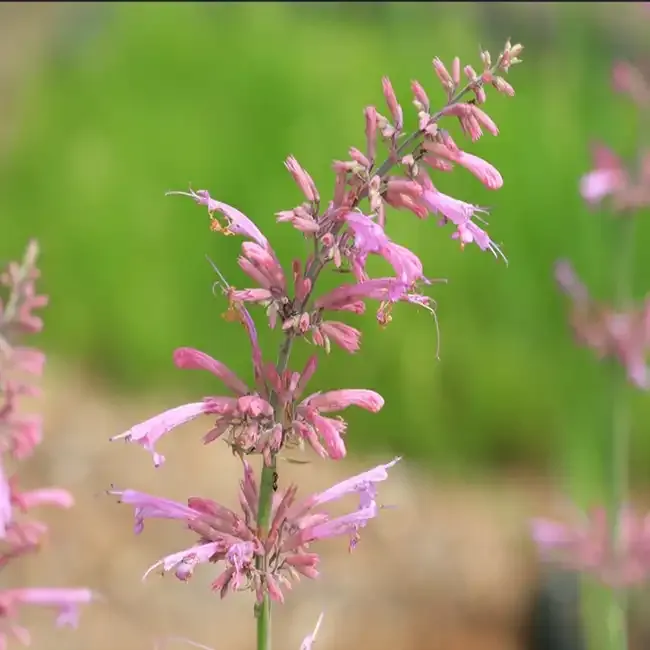
Hummingbird Mint (Agastache) is one of our favorite perennials; it is a pollinator magnet. We plant it in our vegetable garden to attract pollinators. If you add it to your garden, just be aware that it spreads quickly and can take over an area.
This article explores aspects of the Hummingbird Mint, including its native regions, attraction to hummingbirds, soil and moisture requirements, and comprehensive care tips.
Native Region
Agastache encompasses a diverse genus of plants native to various regions across the globe. The majority of Hummingbird Mint species are Indigenous to:
- North America: Many species originate from the southwestern United States and Mexico, thriving in arid and semi-arid climates.
- East Asia: Certain varieties are native to regions in China and Korea and adapt well to different environmental conditions.
These native habitats contribute to Agastache's hardiness and adaptability, making it suitable for cultivation in a wide range of garden settings worldwide.
A Top Hummingbird Attractor
As the common name suggests, Hummingbird Mint is a magnet for hummingbirds and other pollinators like butterflies and bees. Several factors contribute to its attractiveness:
- Vibrant Blooms: The plant produces tall spikes adorned with tubular flowers in hues of purple, pink, orange, and red, which are particularly appealing to hummingbirds.
- Extended Bloom Period: Agastache blooms mid-summer through early fall, providing a consistent nectar source during the critical feeding season.
- Aromatic Foliage: The minty, licorice-like scent of the leaves adds sensory appeal and attracts various beneficial insects while deterring certain pests.
Incorporating Hummingbird Mint into your garden design enhances biodiversity and supports the local ecosystem by providing essential resources for pollinators.
Soil Requirements
Agastache is known for its tolerance and adaptability to different soil conditions, but it thrives best under specific circumstances:
- Well-Drained Soil: Proper drainage prevents root rot and other moisture-related issues. Sandy or loamy soils are ideal.
- Moderate Fertilization: The plant prefers soils that are not overly rich. Excess nitrogen promotes foliage at the expense of flower production.
- pH Levels: A neutral to slightly alkaline pH (around 6.5 to 7.5) is optimal for healthy growth.
Mix heavy or clay-like soil with organic matter such as compost or sand to improve drainage and texture.
Moisture Requirements
While Agastache is drought-tolerant once established, appropriate watering practices are essential for optimal growth and flowering:
- Initial Establishment: Newly planted Hummingbird Mint requires regular watering to develop a robust root system.
- Mature Plants: Once established, reduce watering frequency. The plant prefers moderate moisture levels and can withstand periods of drought, making it suitable for xeriscaping.
- Avoid Overwatering: Continuous moisture can lead to fungal diseases and root problems.
Monitoring soil moisture and adjusting watering practices according to climate and seasonal changes will help maintain healthy and vigorous plants.
Tips for Caring for Hummingbird Mint
Proper care ensures your Agastache plants remain healthy, vibrant, and productive throughout the growing season. Here are some essential care tips:
Planting
- Location: plant in an area that receives full sun for at least 6 to 8 hours of direct sunlight daily. Adequate sunlight promotes abundant flowering and robust growth.
- Spacing: Plant Agastache specimens 12 to 18 inches apart to allow sufficient air circulation and reduce disease risk.
- Planting Time: Spring is the ideal time for planting, giving the plants ample time to establish before summer heat.
Pruning and Deadheading
- Deadheading: As with many other flowers, cut or pinch off spent blooms to encourage new buds.
- Pruning: I prune my hummingbird mint in early spring by cutting back the stems to promote healthy new growth and maintain a tidy appearance.
Fertilization
- Minimal Feeding: Agastache typically does not require heavy fertilization. Applying a light layer of compost in spring can provide sufficient nutrients.
- Avoid High-Nitrogen Fertilizers: Excess nitrogen encourages foliage growth over flowers, making plants more susceptible to pests and diseases.
Pest and Disease Management
- Resilience: Hummingbird Mint is generally resistant to common pests and diseases.
- Potential Issues: To prevent powdery mildew or root rot, ensure your hummingbird mint is planted in well-drained soil.
- Natural Deterrent: The plant's scent deters many pests, making it an excellent companion in vegetable and ornamental gardens.
Winter Care
- Hardiness: Most Agastache varieties are hardy in USDA zones 5 through 10. If you live in a cooler region, add mulch at the end of the season to insulate roots during winter.
- Container Plants: If grown in containers, consider moving them to a sheltered location during extreme cold to prevent root damage.
Propagation
- Seed Propagation: Sow seeds indoors 6 to 8 weeks before the last frost or directly in the garden after the danger of frost has passed.
- Division: Mature plants can be divided in spring or fall to create new plants and rejuvenate older clumps.
- Cuttings: Take softwood cuttings in late spring or early summer and root them in a suitable growing medium.
Hummingbird Mint (Agastache) is a delightful addition to any garden. It offers aesthetic beauty, fragrant appeal, and ecological benefits by attracting many pollinators. Its hardiness, low maintenance requirements, and drought tolerance make it an ideal choice for gardeners seeking both form and function. By adhering to the outlined soil, moisture, and care guidelines, you can enjoy the vibrant blooms and lively visitors that Agastache brings to your outdoor space season after season.
Whether you're a seasoned gardener or a beginner, incorporating Hummingbird Mint into your planting scheme promises to enrich your garden's diversity and charm, provide endless enjoyment, and support local wildlife.
